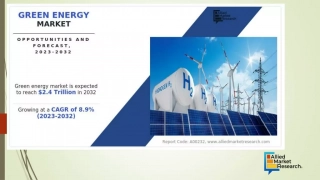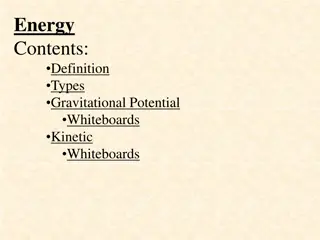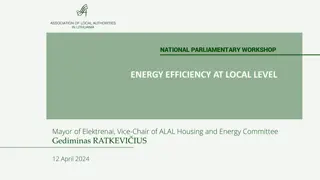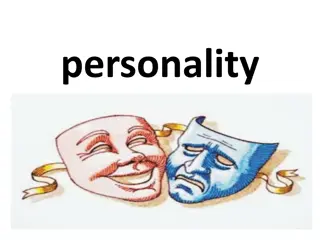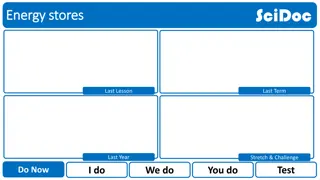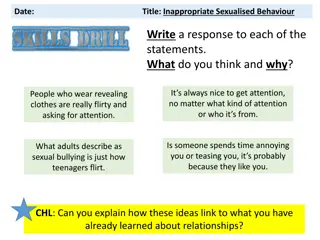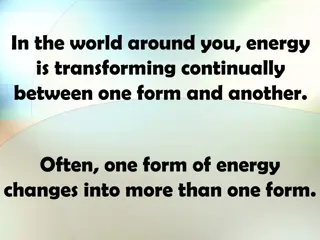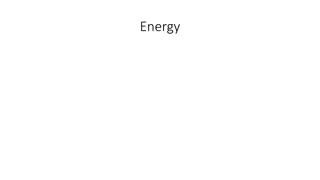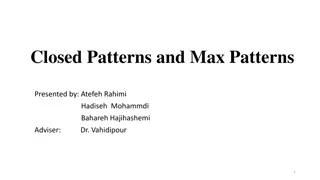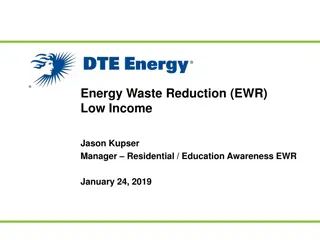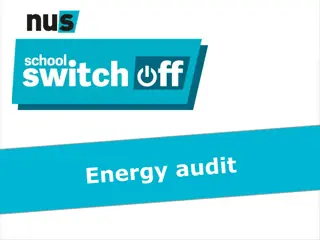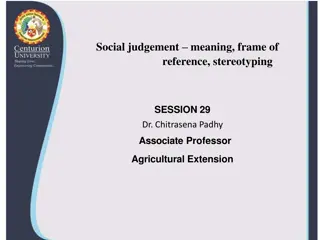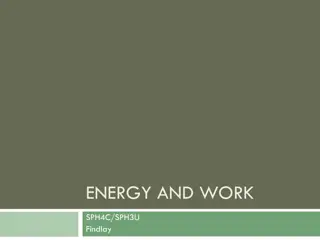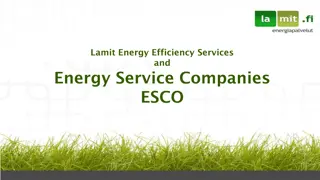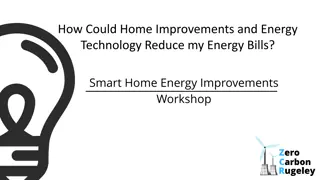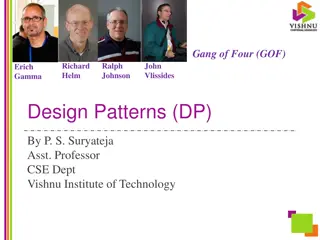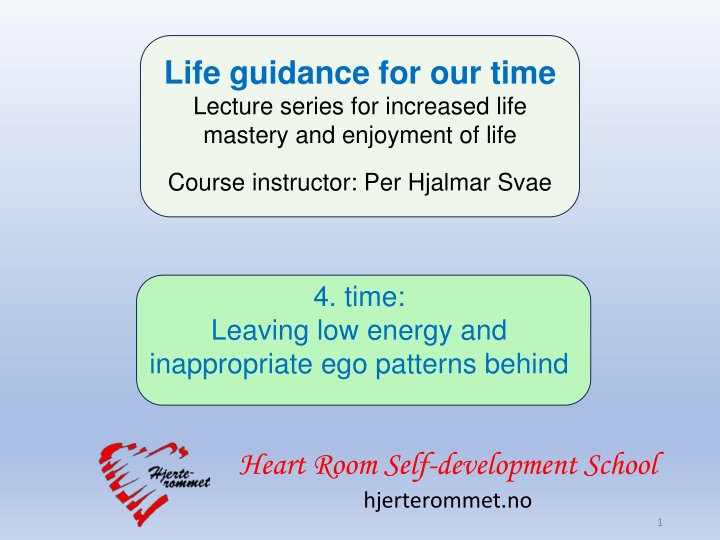
Ego Patterns and Their Impact on Personal Development
Delve into the concept of ego patterns, exploring how childhood experiences shape automated reaction patterns in adulthood. Discover how these patterns affect relationships, cooperation, and overall well-being. Learn to identify and overcome inappropriate ego patterns for personal growth and fulfillment.
Uploaded on | 0 Views
Download Presentation

Please find below an Image/Link to download the presentation.
The content on the website is provided AS IS for your information and personal use only. It may not be sold, licensed, or shared on other websites without obtaining consent from the author. If you encounter any issues during the download, it is possible that the publisher has removed the file from their server.
You are allowed to download the files provided on this website for personal or commercial use, subject to the condition that they are used lawfully. All files are the property of their respective owners.
The content on the website is provided AS IS for your information and personal use only. It may not be sold, licensed, or shared on other websites without obtaining consent from the author.
E N D
Presentation Transcript
Life guidance for our time Lecture series for increased life mastery and enjoyment of life Course instructor: Per Hjalmar Svae 4. time: Leaving low energy and inappropriate ego patterns behind Heart Room Self-development School hjerterommet.no 1
First, we will look at leaving inappropriate ego patterns behind. Inappropriate, negative patterns are what can, over time, create irritation in relationships and cooperation at work. 2
The ego patterns A resouce and a problem As children, we learn to cope with life as best we can. We develop an ego with automated reaction patterns - Ego patterns. An ego pattern is an automated pattern of thought, feeling, will and body postures that has become a permanent character trait. The ego patterns are created to make the best of it in a situation where we as children are not met the way we really need. Resource The ego patterns are automated, locked-in patterns that we repeat as adults, even if it is not appropriate. A Problem The pattern provides substitute solutions (eg, getting one's way) rather than needs satisfaction (eg, mutual care and good cooperation). You automatically repeat behavior that may be inappropriate. In the case of stuck problems in cohabitation and cooperation, the negative aspects of the ego patterns are a part of the problem. 3
The six ego patterns summarized Winnie The Pooh Character Egopatterns Formed by age: No. negativ og positiv prpperties Existentially uncertain Mental and mentally/ spritually giftet -0,3 +0,3 year Piglet 1 Existentially uncertain Emotional and socially/artistically gifted Roo 2 0 0,3 year Malnourished and mentally/analytically gifted Eeyore 3 0 1,5 year Strong-willed with great implementation power 0,8 2,5 year Tigger 4 Surrendering and caring Winnie 5 2 4 year Overachieving and responsible Rabbit 6 3 6 year Source: Body-oriented psychology developed by Wilhelm Reich in the 1930s-1940s, Lowen and Pierrakos in the 1950s-1960s, Barbara Ann Brennan 1980-2020 and Lisbeth Marcher 1990-present. 4
Existentially uncertain Mental variant Body shape is a tendency that often recurs. Of course, heredity, environment, diet and exercise also play a role. The child's life theme in the phase -0.3 - + 0.3 years: Do I have the right to exist? Am I wanted? The cause of the pattern is a birth trauma, being an unwanted child or neglect in the form of hostility, violence, neglect or remoteness at the beginning of life. Positive Properties Stage 3 (Stage 3 in The Development Ladder, see 1st lesson in the Course) Piglet - - - - Negative Properties Stage 2 (in the Development ladder) - Replacement solution: Split. Pull away. Freedom from responsibility - Struggling with fear, anxiety and negative thoughts. - Melancholy. Downcast, pessimistic basic mood - Often distant and mental - Can struggle with social things - Resistance to change. Becomes paralyzed. - Poor life skills - Periods of melancholy and depression Often a special mental or spiritual endowment. Radar for other people's hidden thoughts and feelings Unbound by "tribal laws . Black humor Ability to have deep and serious conversations Typical body: Fragile and hinged. Light and airy. Crooked. But most often other patterns will affect the body more.
Existentially uncertain Mental variant The negative aspects of the pattern listed in the book knekke livets kode (Cracking the Code of Life) To leave the replacement solutions and other negative aspects behind and gain increased life mastery and joy in life - Seeks freedom from responsibility Take more and more responsibility for your own life and for the community - Split. Pull away. Stay in touch and master social skills - Struggling with fear, anxiety and negative thoughts. Learn to meditate and witness the anxiety, not believe in it. Work on and deal with the challenge that causes anxiety. - Resistance to change. Becomes paralyzed. Think again. Practice the challenge. - Often distant and mental Practice being in the present instead of thinking, thinking - Can struggle with social things Practice not leaving this out of the conversation. - Not feeling good enough as you are Affirm that you are ok just the way you are. - Melancholy. Downcast, pessimistic basic mood What do you really want? What makes you gloomy or depressed? How can you get out of the "stuck" negative situation? - Poor life skills Have a good and regular daily routine. Go to bed on time before 11 p.m. Start physical exercise, and you will have more energy and sleep better. 6
Existentially uncertain Emotional variant The child's life theme in the phase 0 - 0.3 years: Am I worth being loved? The reason for the pattern is that they only experienced being loved and cared for as they are for shorter periods of time, so that they learned to get more energy and attention from their parents through attention-generating behaviour. Kengubarnet Positive Properties Stage 3 - Often special social and artistic abilities. Contact with the life core and life energy. Sanguine. Extroverted, alive and entertaining. Ability to penetrate others ego-defenses Negative Properties Stage 2 - Repacement solution: Seeking attention, instead of being loved as you are. Playing through life, instead of taking responsibility Attention seeking. Take your word and keep it. Takes the show in social contexts. Will only do what is pleasurable. Does not like duties. Gets easily hurt and emotional, e.g. jealousy, envy. Behaving childishly and creating fuss and chaos Lose your mind. Hysteria. Destroys things and relationships. Possibly misuse of alcohol/drugs or unexpected breakdown Typical body: A living face, facial expressions and body. The pattern does not appear particularly in the body shape itself, so that other patterns will characterize this. - - - - - - -
Existentially uncertain Emotional variant To leave the replacement solutions and other negative aspects behind and gain increased life mastery and joy in life - Seeking attention Love yourself as you are, without getting attention. Stop taking so much attention in social circles. Seek deep and close contact with friends and lovers and feel that they like you without you entertaining them. - Playing through life Take more responsibility for your own life and duties. - Will only do what is pleasurable Have good routines and du your duties. - Childish behavior, creating fuss and chaos Stop acting like a "kid" who has to have his way! Use mental control to stop yourself. Go outside and calm down. Apologize for any dramatization and commotion. Ask for a calm conversation at a later time. Tell yourself that others love you and value you, even if you don't always get your needs met. - Lose your mind. Emotional. Hysteria. Destroys things and relationships. - Possibly misuse of alcohol/ drugs or unexpected breakdown Accept yourself as you are, accept and embrace life as it is, and develop better coping skills. To succeed in this, you may need professional help. 8
Malnourished The child's life theme in the phase 0 - 1.5 years: Can I have my needs met and learn to master the body and life? The reason for the pattern is that there was not enough, or good enough, loving care and good enough cooperation in helping the child meet his needs and cope with life. Possibly also physical malnutrition. Eeyore Positive Properties Stage 3 - - - - Mental, logical and analytical abilities Often a good educator Kind, straightforward and helpful Full of ideas and plans. Wry-witted Negative Properties Stage 2 - Replacement solution: Mental contact, instead of feeling contact and body contact, both inside and outside. Is too mental and has poor emotional contact Has too little contact with own needs Malnourished himself. Says no thanks! Or the opposite: Needy. Gives to get. Not enough energy and ability to implement ideas and plans Doesn't understand the issue of informal power Alternating overoptimistic and overpessimistic - - - - - - - Typical body: High and thin
Malnourished To leave the replacement solutions and other negative aspects behind and gain increased life mastery and joy in life - Is too mental and has poor emotional contact Seek emotional and physical contact, within yourself and with others. - Has too little contact with own needs Feel it in your body and your feelings. Ask yourself: What is the need there? Do you want what others are suggesting, or is the answer no? - Malnourished himself. Says no thanks! Take care of yourself instead. - Or the opposite: Needy. Gives to get. Every time you give to others, do you really want this for yourself? - Not enough energy and ability to implement ideas and plans Train your endurance and execution skills. - Doesn't understand the issue of power Learn to "sell" what you want to achieve. - Overoptimistic og overpessimistic Learn to notice the signs that you have fallen back into this, and learn methods to get out of it and be realistic. (Se 5th time in this course) 10
Strong-willed The child's life theme in the phase 0.8 - 2.5 years: Do I have the right to my own thoughts and feelings? The reason for the pattern is that the parents invaded them with their thoughts, feelings and attitudes and demanded that they conform to their will. Also, free child-rearing will be able to create the pattern, because no limits are set for the child's behavior. Positive Properties Stage 3 Tigergutt - - - - - Willpower, execution power and leadership skills Good at building alliances Charming, confident and humorous Has a lot of energy and is warm in the body Eager to train others Negative Properties Stage 2 Repacement solution: Get their way instead of dialogue, mutual care and good cooperation. Choleric. Gets sour and angry easily Mistrust and demand mentality Does not respect others' boundaries, selfish Raises and criticizes everyone but himself Can't stand being caught off guard and can't stand criticism Can lie without blinking. Gets energy from being in battle. Don't forget and don't forgive Typical body Inflated chest and/or hip part. Thin legs.
Strong-willed To leave the replacement solutions and other negative aspects behind and gain increased life mastery and joy in life - Must be right and must have his will "Turn off" your will and be open instead. Ask and listen to others. Find out what they think, want and need. Care for others. - Mistrust and demand mentality. Choleric. Gets sour and angry easily. Choose to trust others. Keep it to yourself if you are angry and upset. Ask yourself what your underlying need is and express it by wanting and asking, not demanding. Does not respect others' boundaries, selfish Develop a conscious attitude towards approaching others. Raises and criticizes everyone but himself When you want to raise others, ask yourself if you might need to sharpen up when it comes to the same thing? Can't stand being caught off guard and can't stand criticism Say that this came unexpectedly and that you need to think about it. Can lie without blinking. Gets energy from being in battle. Say you need to think about it. Stop lying! Having a lot of energy is great, but scale back on the fights you're in. Don't forget and don't forgive By forgiving, you free up energy and have better relationships with others. Creates a ranking with himself at the top Practice being safe without power and control. - - - - - 12 -
Surrendering The child's life theme in the phase 2 4 years: Do I have the right to my own will? The reason for the pattern is that they were regulated in detail and coddled too much as children and obediently surrendered to their parents to get the security, comfort and coziness it provided. Positive Properties Stage 3 - Create coziness and coziness. Calm moods. - Has care for everyone - Round and pleasant. Good for conversation - Good diplomats. Sustainable - Can be good leaders Negative Properties Stage 2 - Repacement solution: Be friends and have a good time even if deeper needs are not met. - Surrenders and submits to the will of others - Don't trust your own judgment. Asks/involves others. - Shame- and guiltfeelings - Phlegmatic. Indolence. Thinking slowly. - Lazyness. Often does not master the details of life - Talking about the problems more than going into them - Comfort eating Winnie The Pooh Typical body: Thick all over. Friendly face.
Surrendering To leave the replacement solutions and other negative aspects behind and gain increased life mastery and joy in life - Create coziness and coziness. Calm moods although own needs are not met. Also dare to set boundaries and speak up to meet deeper needs. Surrenders and submits to the will of others Know what you really want, need and want. Dare to take risks and stand up for yourself! Don't trust your own judgment. Asks/involves others. Train your judgment. Choose to trust it! Stop involving others in every decision. Shame- and guiltfeelings Dette er angripe deg selv! Bevisstgj r disse f lelse og affirmer at du er ok som du er. Thinking and working slow That's just the way it is, but you can train to be faster. Lazyness. Often does not master the details of life Pull yourself together and do it. Practice mastering more and more of life's details. Does not feel OK as a person Affirms that you are okay and valuable just as you are. Talking about the problems more than going into them. Comfort eating Dare to look the challenges in the eye. Notice what you are dissatisfied with and dare to try to change it. - - - - - - - 14
Overachieving The child's life theme in the phase 3 6 years: Do I have the right to be myself the way I am? The reason for the pattern is that they themselves and their natural feelings were not seen and appreciated at the age of 4-6, but that they received a lot of recognition and praise for what they achieved. Petter Sprett Positive Properties Stage 3 - - - - Matter-of-fact, efficient, take responsibility and perform. Always smiling and positive. Focus on achieving good results Lots of energy and smiling "always" Great self-control. Likes boy s type of play Negative Properties Stage 2 - Repacement solution: Accomplish a lot on the matter level, but don't get to take care of the emotional side. Seeking recognition instead of contact and closeness . The focus is too much on matter in relation to feelings Hardness, emotional coldness and/or arrogance Can feel that life is empty and unrewarding Can take the fur from others Three variations of personality types: The Seducer, The Idealist, or "The Saint"/God-fearing - - - - - Typisk kropp Velproporsjonert, men stiv i hofte og bryst.
Overachieving To leave the replacement solutions and other negative aspects behind and gain increased life mastery and joy in life - Over-responsibility for plans and what has to be done Demand less from yourself and others. Take emotional care of yourself and others too. Take breaks, relax and enjoy yourself every now and then. Give others some care too. Can take the fur from others It's nice to be skilled and efficient, but don't brag about it. Can feel that life is empty and unrewarding Go to therapy to gain increased emotional connection? Not contact with feelings. Hardness, emotional coldness and/or arrogance Do what you can to get out of this. Go to therapy? - - - - Negative sides for three different variations of the pattern, discussed in the book. o Closed heart and spirit, but sexual contact Stop seducing o Closed spirit and the sexual, but the heart Nice to be a caring and committed resource. But what about getting more in touch with desire and play? o Closed heart and the sexual but spiritual contact Nice to be a religious person, but the warmth of life lies in the heartfelt and sexual. 16
You leave inappropriate patterns behind through self- observation, self-reflection and testing. 1. Self-observation How did I function today? How did I function in that conversation? How did I function in that company, at that meeting, in that situation? You can also ask others what they think of you and what you did. 2. Self-reflection Why did I do what I did? Was it fear? Was it mistrust? What did I really want to achieve? What was my need in that situation? What ego pattern was I operating in? What step on the developmental ladder was I operating on? Why did the other person(s) react the way they did? 3. Testing What could I have done that would be functioning at 3rd, 4th or 5th step on the development ladder? Think of one or more good reactions and courses of action. How and when can I put this into practice? Try it out. + therapy and coaching?
The three-part brain + our heart The heart is also a control center The Thinking Brain , The Analytical Brain (Neocortex) The Emotional Brain, The Mammal Brain (The Limbic System) The Survival Brain, The Reptilian Brain (The Brainstem) Low energy comes from these two brains The emotional and survival brain These are the two lower brains. They are only able to see one side of the story: your own! The thinking brain is the higher brain Only with the help of the thinking brain are we able to see two sides of an issue. The heart is an even higher governing organ Only when we open our hearts are we able to have compassion for others. Only when we think with our hearts are we able to care for others.
Positiv og negativ motivasjon Positive motivation At the top three levels, it is security, trust and caring that govern emotions, thoughts and actions. Create something positive The Development Ladder (explained in lecture 1) Negative motivation At the two lowest levels, fear, distrust and greed (egoism) control emotions, thoughts and actions. Create something negative
Feelings on different levels in The Development Ladder Source: David Hawkins: Letting Go The Pathway to Surrender Le vel God-view (Energy) Level -Feeling Life-view Energy Emotion Process 700 - 1000 Pure Consciousness Enlightenment 5 Self Is Ineffable 5 Peace All-being Perfect 600 Bliss Illumination 4 Joy One Komplete 540 Serenity Transfiguration 4 Love Loving Benign 500 Reverance Revelation Understanding 3 Reason Wise Meaningful 400 Abstraction 3 Acceptance Merciful Harmonious 350 Forgiveness Transcendence 3 Willingness Inspiring Hopeful 310 Optimism Intention 3 Neutrality Enabling Satisfactory 250 Trust DespoRelease 3 Courage Permitting Feasible 200 Affirmation Empowerment 2 Pride Indifferent Demanding 175 Scum Inflation Antagonistic 2 Anger Vengeful 150 Hate Aggression 2 Desire Denying Disappointing 125 Craving Enslavement 2 Fear Punitive Frightening 100 Anxiety Withdrawal 2 Grief Disdainful Tragic 75 Regret Despondency 2 Apathy Condemning Hopeless 50 Despair Abdication 1 Guilt Vindictive Evil 30 Blame Destruction 1 Shame Despising Miserable 20 Humiliation Elimination
Time-out method Can be used if you fall low and start arguing Stop the argument Tell the other person that "now we're taking a time-out. We'll come back to this discussion later. Get back to feeling good about yourself and each other Live your normal life yourself and together Go to work and do what you have to do Be with the kids? Be with friends? Maybe do something nice together? Maybe a distraction? Watch a good movie together? Then it's time to try to have a good dialogue about the difficult topic, where both of you take care to stay calm Maybe first say what you yourself did that led to the argument last time? Maybe use a method for good communication? For example. The talking stick method? For example. write down arguments for and against on a piece of paper? In the worst case, ask for help from a friend/professional to lead the conversation? 22
Self-observation, self-reflection and testing are also the way out of fear, anxiety, anger and other negative energy. 1. Put into words that you are overcome by fear/ distrust/ negativity/ anger/ blame. For example, worry, distrust, anger, condemnation, lack of courage, despair, overachieve- ment, etc. That is, all forms of emotions that are deeply rooted in fear and distrust. 2. Stop and take a time-out Stopp deg selv i fortsette handle ut fra frykten eller en av dens mange avledninger. 3. Witness the fear/negativity and engage in self-observation and self-reflection Let the fear/negativity take over your mind and engage in self-observation and reflection. What are you really feeling? What do you feel like doing? Why? Behind fear/negativity/anger there is often an unmet need. Put words to this need. This way you can find out what is causing it and what need you really have. You can also talk to others about it. 4. When fear calms down, think and act with positive motivation (esperimentation) Contact that place in your heart that is filled with kindness, compassion, and forgiveness toward yourself and others, so that you can come into positive energy. Then you devise a way to communicate and act that best meets the need. The wisdom behind the method is: What you give energy to, grows in the psyche. What you do not give energy to, diminishes. By witnessing the fear and simply reflecting on it, you do not give energy to the fear. Source: Penny Gill: What in the World Is Going On? Wisdom Teachings for Our Time
Getting out of negative attitudes which can irritate and trigger others This is, in a profound sense, about lifting your personality from 2nd step to 3rd step on the development ladder. Victim mentality: Stuck in hurt and anger, shame and guilt. Feeling sorry for yourself. Blaming others. Complaining and whining. Can't handle it. Don't want to. It's no use! Etc. Demand mentality: Demands that others come to you, change, sort things out. Etc. Comes with criticism, attacks. Lack of independence: For example, leaning too much on others. Not being able to make important choices. Not daring to do what you really want. Awkwardness. Lack of ability. Helplessness. Etc. Herd mentality: Dependence on the opinions and will of others. Trying to be like everyone else in the "herd" and be liked and accepted. Lack of mental control: The challenge is to gain control over lower impulses and drives at the 2nd stage, so that these are not lived out in real life: Jealousy, envy, anger, greed, etc.
Self-development is like making a new path in the forest. What we do in practice is creating new, well- functioning brain pathways and letting old, inappropriate brain pathways weaken and die out. First you have to figure out where the new path is going to go = Finding a good way of being or a good alternative to the undesirable, e.g. always being in the tolerance window. Then you have to make the path and step and step to make it a path = Practicing and practicing being in the tolerance window and practicing the care star. Then the old path slowly grows back because you don't use it = you no longer fall into the old pattern and become emotional. . And finally the new path has become easy to walk = the new and better has become automated, being in the tolerance window. 25 Free course: Life guidance for our time hjerterommet.no/livsveiledning/
Book and compendiums Available as pdf-files in Norwegian, which you can use webtools to translate to your language Book 2: Leaving Inappropriate Ego Patterns Behind A4 116 pages Breaking the Code of Life - A Path to Good Lives, Partnerships and Society A5 260 pages Book 3: Leaving Low Energy Behind A4 98 pages knekke livets kode Bok 2 legge uhensiktsmessige egom nstre bak seg Per Hjalmar Svae Dette heftet f lger opp boken: knekke livets kode - Veien til det gode liv, samliv og samfunn I dette heftet f r du veiledning om hvordan du i praksis kan utvikle din personlighet slik at du i kende grad fungerer som et selvstendig, velfungerende individ p tredje trinn i utviklingsstigen, og unng falle lavt ned (trinn 2 og 1) i utviklingsstigen, som du l rer om i Bok 1 og som blir kort repetert i dette heftet. Hjerterommet forlag og kursvirksomhet Hjerterommet.no

